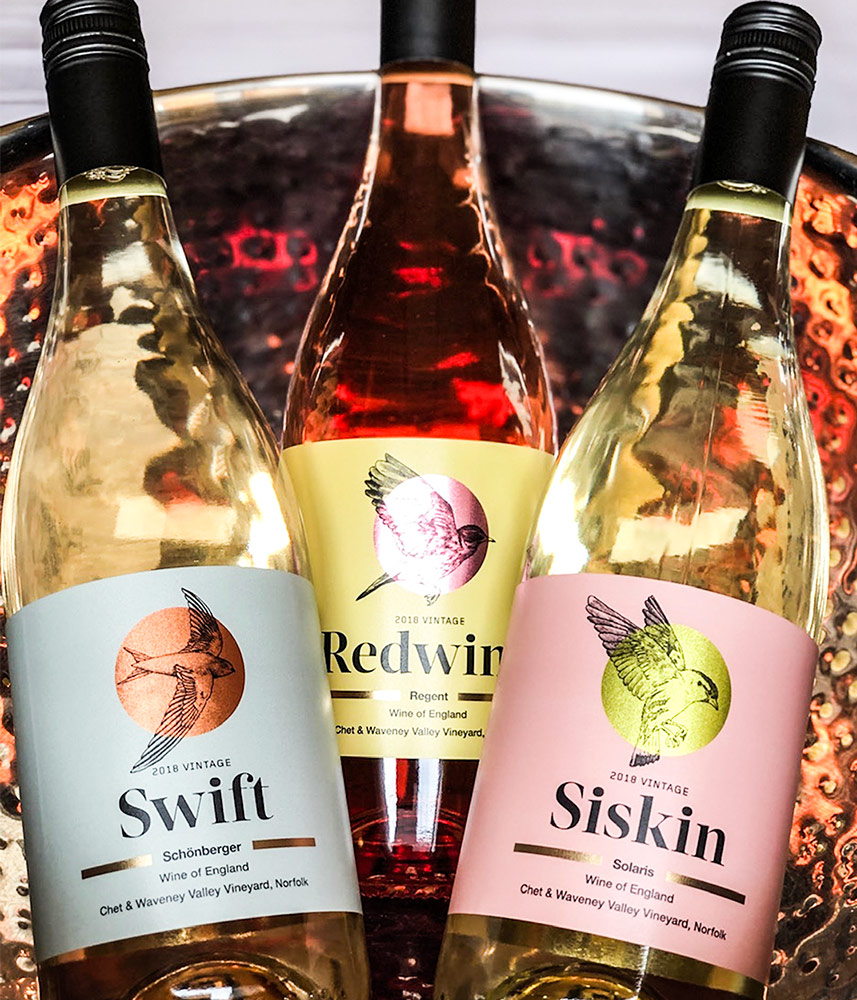Birds are never far from the conversation at Chet and Waveney Valley Vineyard. Our feathered friends (principally Blackbirds and Starlings) can be greedy pests here and the local Sparrowhawk hasn’t scared sufficient numbers away recently. But birds are sufficiently respected for various native and migrant species to feature on the bottles they make at Chet. The vineyard lies to the southeast of Norwich, near the village of Bergh Apton. Situated in gently undulating countryside, rather than the flatlands of the Norfolk Broads to the north, Chet contains a number of different soil types: sandy loam near the top, then sandy gravel, and finally, from glacial deposits, chalky clay at the bottom. John Hemmant, owner and winemaker, believes this mix of soils provides an ideal combination of good drainage and a purity in the bottle.
John, Norfolk through and through, first made wine at his father’s farm in Sisland (the next village along from Bergh Apton), putting his degree in Chemistry to good use. He has had stints working as a food scientist but winemaking is his labour of love and, ten years ago, he planted the first vines at Bergh Apton. Currently making 8000 bottles, John plans to double his production by increasing his land under vine to over 20 acres. There is a mix of classic Champagne grape varieties and Germanic crosses on site but it is the latter that contributes most to both sparkling and still wines here. Phoenix and Seyval Blanc make up the bulk of the sparkling wine production, both in the three Charmat-style ‘Skylark’ wines, and the Méthode Champenoise, ‘Horatio’. John makes three varietal still wines, two whites from Schönburger and Solaris respectively, and a rosé from Regent. The Pinot Noir may make a still red in a hot year but the Chardonnay hasn’t yet been put in any of the sparkling wines, and is a little way off producing viable fruit.
I asked John why he hadn’t made a varietal Bacchus yet. He felt that Bacchus produces individual wines that dominate with gooseberry flavours, and very often lack subtlety, although he admits there is a successful market for these wines. John has planted some Bacchus and would like to experiment with it in blends; he is bucking the trend of globalising single varieties, and enjoys the old school of blending. He thinks also that Bacchus could be combined with a less aromatic variety, such as Chardonnay, to add finesse.
Dornfelder is another variety that he is trialling, and John was encouraged to hear about the success neighbouring vineyard, Winbirri, has had with this grape. Currently, he makes 75% sparkling and 25% still but that percentage may well change; their 2018 Solaris still wine sold out in double quick time. Charmat winemaking is, John acknowledges, controversial in some English Wine circles. He believes that there is a snob value in promoting Champagne-style wines but using the tank method is a no-brainer as far as he is concerned - quicker to market, cheaper to make. And, crucially, approachable in style.
John and his wife, Bridget, have ambitious plans for the future. They have recently refurbished self-catering Airbnb accommodation on site, and they are currently building a new winery. The old winery will be used for storage, and they also plan to have a new cellar door shop. It was in the sitting room of the guest cottage where we tasted John’s wines, starting with the 2018 ‘Swift’, made from Schönburger. This was an aromatic delight with rose water and lychee on the nose, and a dry, grassy palate of pear and melon with a hint of Turkish Delight. Comparisons with Gewürztraminer were inevitable. Next came the 2018 rosé, ‘Redwing’ (a thrush that summers in Scandinavia and winters here), made from Regent. This had lovely aromas of sweet strawberry and vanilla. On the fairly dry but fruit-forward palate there were flavours of pomegranate, raspberry and winter spice. I was disappointed not to be able to taste the 2018 ‘Siskin’ (the Solaris that had sold out) but I have tried the 2017. I was impressed with the oily and earthy complexity of that wine but John assured me that the following vintage was a significant improvement.
Then it was on to two of the ‘Skylark’ Charmat sparkling wines, the Blush Brut and the Demi-Sec. My palate is used to drier bubblies but both these wines charmed with their unalloyed fruit and sheer drinkability. The Blush Brut had sherbet and almond on the palate alongside red cherry flavours. The Demi-Sec had caramel on the nose with ripe peach and apricot notes on the taste. Finally, it was the turn of my favourite wine of the portfolio, ‘Horatio’. The extra time on lees has given this wine real complexity with sophisticated herbal flavours and notes of glacé cherries, pears and sherbet.
Thanks go to John and Bridget for their generous hospitality. I look forward to future wines from Chet Valley, perhaps ‘Robin’ for a still Pinot Noir and, dare I say it, ‘Sparrowhawk’ for a sparkling Champagne method cuvée - if the local raptor does its job.
Additional photos with thanks to Chet Valley Vineyard.
- 10 Acres
- By Appointment







